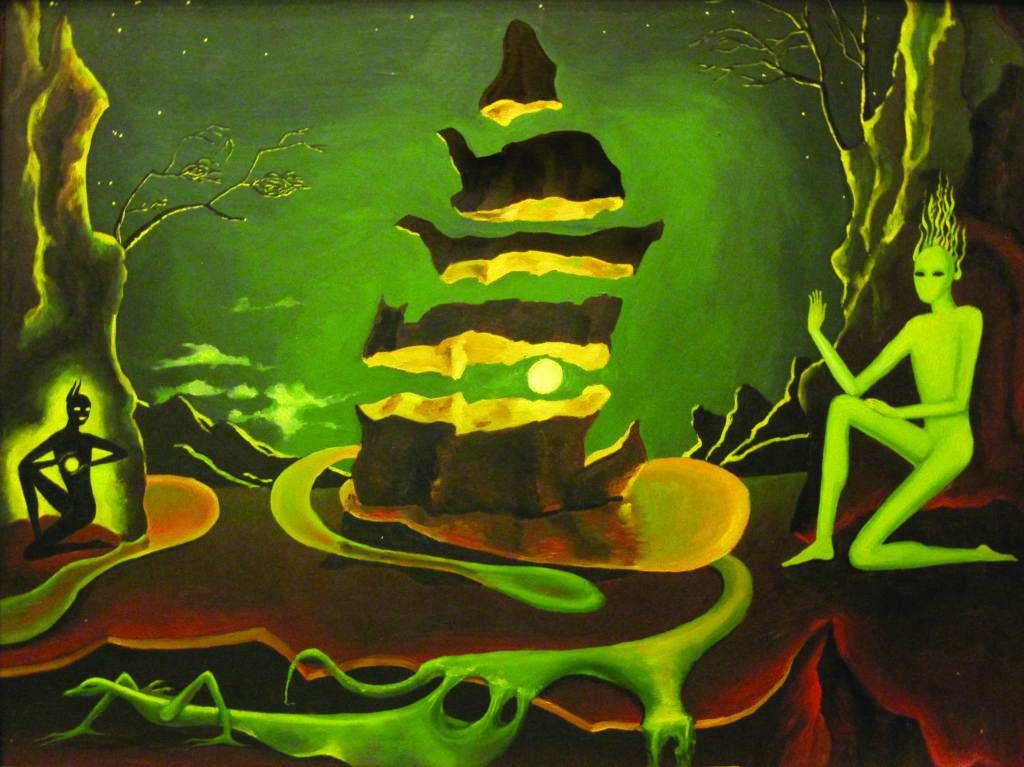Oneirogen Alternatives
to Intoxicants
BY JENNIFER DUMPERT

What do you do when the weekend rolls around? For many people, it’s time to open a bottle of wine, smoke some pot, or even swallow something stronger for a deeper journey. Tweaking consciousness is hard-wired into the human experience. Little kids roll down hills and spin in circles. Adults take intoxicants to achieve altered states. We love to leave the everyday behind and experience ourselves in new ways. The impulse is natural, but many of us worry about the long-term adverse health effects, as well as next-day hangovers. But you don’t have to ingest poisons to play with your mind. Next time you have the urge to experiment with your consciousness, consider the original altered mind adventure: the dream. And if part of the fun involves taking substances to see how they affect you, try an oneirogen.
From the Greek oneiro (dream) and gen (to create) and pronounced “oh NIE ro jen,” it is any herb, root, sound, scent, or food that promotes vivid dreaming. Oneirogens range from teas used by indigenous cultures for divination to phone apps that entrain brainwaves.
Your dream life is deeply personal and unique, yet dreaming is a phenomenon shared by all people everywhere. Consciousness exploration goes hand in hand with community. From psychedelics to wine tasting clubs, we love to share the experience of spelunking our inner realms. If you’re looking to try oneirogens in company, consider joining the Oneironauticum.
Founded in January of 2008, the Oneironauticum is a worldwide intentional slumber party dedicated to the exploration of oneirogens. During each Oneironauticum event, a group gathers to sleep in the same place and try an oneirogen. On that same night, participants around the globe use the same oneirogen. In the morning, those gathered together eat breakfast and talk about their dreams. Remote participants Skype in or join a Google Hangout, or send their dreams by email. These dreams are saved on the Oneironauticum website, where they can be sorted by oneirogen.
People participate for a variety of reasons. Some want to learn lucid dreaming skills. Some seek healing dreams or pursue therapeutic use. We have participants who believe in oneiromancy, a kind of divination through dreams. Some participants try to meet each other in dream worlds. We also have practices that focus on promoting creativity and problem solving. For many of us—including me—the main purpose remains consciousness experimentation.
Over years of experimentation, the Oneironauticum community has developed a few favorite oneirogens. If you try any of these, keep in mind that not everything works for everyone. A lot of factors go into how well an oneirogen will work for any person. But it’s likely that at least one will resonate with you.
Calea Zacatechichi
This flowering plant is traditionally used by the Chontal natives indigenous to the Mexican state of Oaxaca for oneiromancy. They believe that dreams happen in realms beyond those we consciously perceive and that dreams can convey meaningful messages or prophecy. They further maintain that Calea clarifies the senses so the dreamer can more clearly perceive insights and bring them back into waking memory. Some people use Calea to induce lucid dreams. Calea is brewed into an astoundingly bitter tea or smoked.
Somnium
Most of your senses get shut down during sleep so you don’t act out your dreams. Hearing and smell remain active, however, making sound and scent excellent oneirogens.
During the 1980s, electronic musician Robert Rich performed a series of all-night concerts for sleeping Bay Area audiences. To maximize dreaming, he composed pieces that alternate sound textures to match the phases of sleep. The key of these pieces is to keep the mind as close to consciousness as possible without waking it. Somnium is a 7½ hour soundscape you play while asleep.
Binaural Beats
Although they’ve been around since the 1970s, binaural beats are undergoing a resurgence of interest thanks to phone apps that easily produce them. When two different frequencies—brainwave rhythms—are played in left and right ears through headphones, the brain falls into the rhythm of the difference between the frequencies, such as theta or alpha.
Binaural beats apps have settings for different sorts of dreams, such as lucid dreams. If you can’t sleep comfortably in headphones, look for an app that offers hypnagogic dreams, the incredible dream state between waking and sleeping.
Mugwort
Mugwort refers to several species of plants in the Artemisia genus. In Korean bath houses, mugwort soaked in water is poured over hot rocks at night to induce vivid dreams. Although it can be made into a tea, the Oneironauticum group works with mugwort as an olfactory oneirogen.
The scent of mugwort produces saga-length, intricately detailed dreams. It also improves dream recall. Make a sachet of dried mugwort and oil and place it near you while you sleep.
The next Oneironauticum happens on the night of December 9 in Oakland. Although the in-person group is already full, anyone can participate remotely. A talk about dreamwork will be live streamed at 10 p.m. on December 9, and digital dream sharing will happen at 10 a.m. on December 10. The oneirogen will be Robert Rich’s soundscape Somnium, available free on the Oneironauticum website for anyone who wants to participate.
Oneirogens also make wonderful holiday gifts. On the evening of Sunday, December 18, join me for a talk about oneirogens at Twisted Thistle Apothecary on Haight Street in San Francisco. The herbs and roots discussed will be for sale, along with information about how to use them to promote dreaming.
Jennifer Dumpert is a San Francisco–based writer and lecturer, and founder of the Oneironauticum. UrbanDreamscape.com